Most telescopes come with one or two eyepieces, which gives you one or two magnification options. However, if you want to optimize your viewing experience, you’ll need to invest in a better-quality eyepiece. By having a range of magnifications, you can optimize the image, which means you need more eyepieces.
I want to help you select the best eyepieces for your telescope and your budget. So, I am going to organize the guide around five questions and four formulas.
As we go along, I will refer back to these, so don’t worry if you can’t answer the questions or understand the formulas now. Once we are done, they will make sense.
Questions:
- What is my budget per eyepiece?
- What diameter eyepieces will my telescope accept?
- What focal length eyepieces should I buy?
- What apparent field of view and eye relief do I want?
- How will my telescope’s focal ratio affect my purchases?
Formulas:
- Magnification or power = focal length of telescope / focal length of eyepiece
- True field of view, or FOV = Apparent field of view (AFOV) of the eyepiece / magnification
- Focal ratio = focal length of telescope / aperture of telescope
- The maximum practical magnification of a telescope is typically 40-60x per inch of aperture, or 1.6-2.5x per mm.
- Exit pupil = telescope focal ratio / focal length of eyepiece
Don’t worry about the math, as it’s simple stuff you can do with any calculator, on paper, or perhaps in your head. These are things you will want to know and use.
If you just want the best eyepiece recommendations and don’t care about the details, I’m adding that section right below before we go into the specifications that answer the above questions and make use of the formulas. But I think you will feel more confident about your purchases and be less likely to be disappointed if you read through the guide.
Recommendations – The Best Telescope Eyepieces We Know
To get the best performance, you have to be willing to pay the price. But the difference in price to get to the next level is high, and the performance difference may be small. But some people demand the very best, and it is available, at a price.
When selecting the best eyepiece for your telescope, consider:
- Your budget
- The magnification range that is appropriate for your scope.
- Know what diameter eyepieces your scope takes.
- Pay attention to the eye relief, especially if you will be observing with glasses. Note that unless you have severe astigmatism, glasses are unnecessary; the only effect of severe near- or far-sightedness is a different focus placement than people with good vision, though in more mild cases this effect is negligible.
- Look at the apparent field of view specs and understand what this means for the field of view.
- Be aware of the focal ratio of your scope.
Eyepieces are standardized, so whatever investment you make today, the eyepieces will continue to serve you in any future scopes you may own. A premium eyepiece that costs nearly as much as your telescope itself may seem silly, but it’s more sensible than getting a low-quality ocular you’ll quickly find yourself putting away or getting rid of when you grow unhappy with its performance.
What follows are specific eyepieces that I have tried, own, or have read so many good reports about that I feel very comfortable recommending them. Note that the price categories are approximate, as prices can vary between retailers.
Our Eyepiece Picks
Under ~£65, Choice 1: BST Starguider/Omegon FlatField ED
Available 1.25” focal lengths: 25mm, 18mm, 15mm, 12mm, 8mm, 5mm, 3.2mm
Pros
- Affordable
- Sharp views
- Long eye relief
- 60-degree apparent field of view
Cons
- 60-degree field isn’t the widest option there is
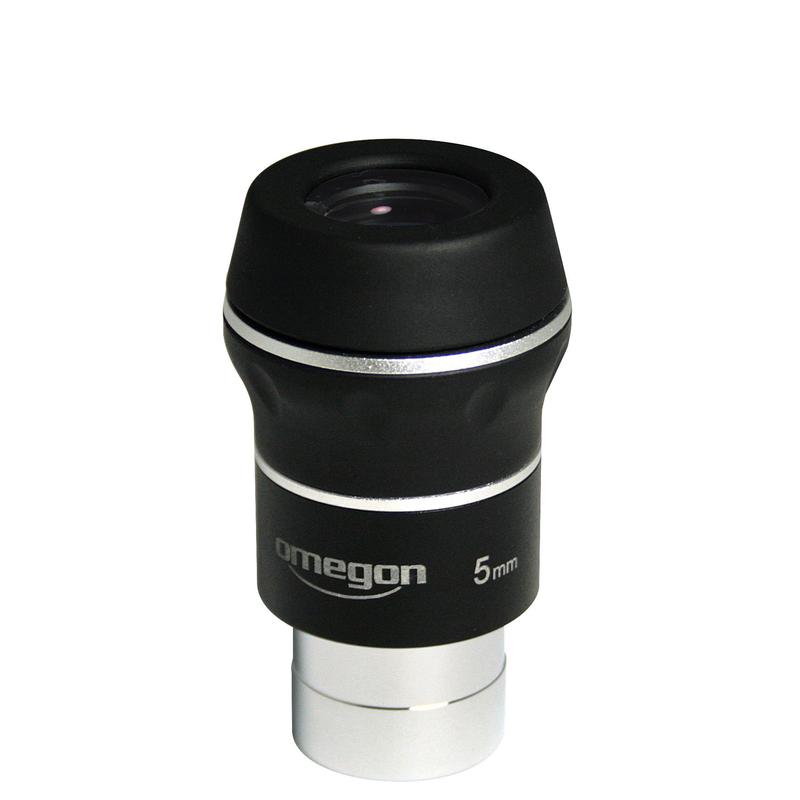
Under ~£65, Choice 2: OVL ExtraFlat 1.25”
Available 1.25” focal lengths: 27mm, 19mm, 16mm
Under ~£65, Choice 3: StellaLyra SuperView
- Available 2” focal lengths: 50mm, 42mm, 30mm
- Available 1.25” focal lengths: 20mm, 15mm
Pros
- Affordable
- Sharp views
- Decent eye relief
- 68-degree apparent field of view (except in 50mm, which is only a 55-degree AFOV)
Cons
- Some off-axis astigmatism in 2” units
- Field curvature/sharpness issues at faster f/ratios
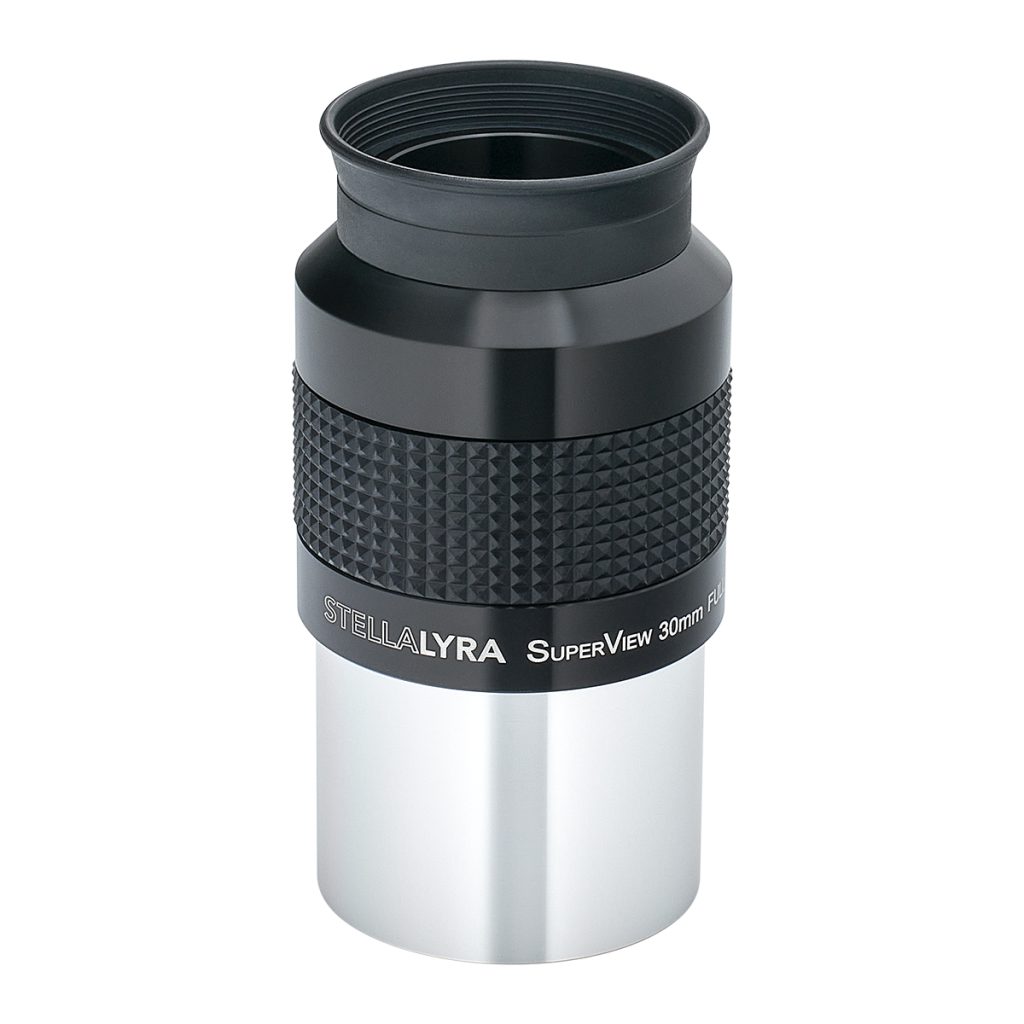
Under ~£65, Choice 4: Redline/Goldline Eyepieces
This series of eyepieces may provide the best possible value in their price range. They can be recognized by a thin gold or red line just below the eye cup. Many brands of eyepieces are available, including SVBONY, Sky-Watcher, and RVO UltraWide. They are all made by the same OEM manufacturer. These companies rebranded them under their own names.
The “redline” and “goldline” eyepieces are minimal in differences optically, but the redlines are a little more well-constructed not to mention looking quite a bit prettier.
Available 1.25” focal lengths: 20mm, 15mm, 9mm, 6mm
Pros
- Edges of the optics are blackened for increased contrast, which prevents internal reflections
- Anti-reflection, fully multi-coated optics provide enhanced light transmission for bright and clear images
- Wide 66+ degree apparent field
- Plenty of eye relief
Cons
- 20mm especially poor in fast telescopes
- 6mm tricky with eye positioning
- Not available in longer focal lengths
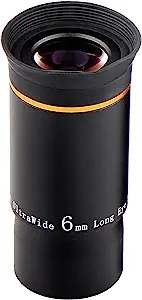
Under ~£65, Choice 5: Sky-Watcher Planetary Eyepieces
Available 1.25” focal lengths: 25mm, 20mm, 15mm, 9mm, 8mm, 7mm, 6mm, 5mm, 4.5mm, 4mm, 3.2mm, 2.5mm
Pros
- Wide 58-degree apparent field
- Plenty of eye relief
- Decent performance
Cons
- Quality issues occasionally
- 58-degree field isn’t the widest
Under ~£65, Choice 6: Takahashi Starbase Orthoscopics
Available 1.25” focal lengths: 20mm, 18mm, 14mm, 9mm, 6mm
Under ~£65, Choice 7: StellaLyra LER
Available 1.25” focal lengths: 18mm, 14.5mm, 12.5mm, 9mm, 6mm, 5mm, 3mm
Under ~£65, Choice 8: Antares W70
Under ~£65, Choice 9: SVBONY SV207 Plossl
Plossl eyepieces are a popular choice among amateur and professional astronomers due to their simple, yet effective design. The SVBONY SV207 Plossls offer superior quality to many of the cheaper Plossl options out there, featuring wide, comfortable rubber eyecups that facilitate viewing both with and without eyeglasses. They also boast slightly increased eye relief compared to rival models and deliver outstanding sharpness, making them provide excellent value for your money. While many people will stay with and add Plossls to their eyepiece set, we would recommend not going below 10 mm focal length as the eye relief gets quite short.
Pros
- Affordable
- Sharp optically
- Comfortable eyeguards
Cons
- 50-degree apparent field is rather narrow
- A little more expensive than competitors
- 8mm has poor eye relief
Under ~£65, Choice 10: Celestron Omni Plossl
Under ~£65, Choice 11: Sky-Watcher SP Plossl
| Eyepiece | Rating | Available Focal Length |
|---|---|---|
| Celestron E-Lux | 4.2 | 2″-40mm, 32mm, 26mm |
| Vixen NPL Plossls | 4.2 | 1.25” – 40mm, 30mm, 25mm, 20mm, 15mm, 10mm, 8mm, 6mm, 4mm |
| Astro Essentials Super Plossl | 4.1 | 1.25″ – 40mm, 32mm, 26mm, 20mm, 15mm, 12.4mm, 9.7mm, 6.4mm |
| Meade Series 4000 Plossl | 4.1 | 1.25″ – 40mm, 32mm, 26mm, 20mm, 15mm, 12.4mm, 9.7mm, 6.4mm |
| SVBONY Plossl | 4 | 1.25” – 23mm, 10mm, 4mm |
| Aspheric Eyepieces | 3.8 | 23mm, 10mm, 4mm |
£65 – £125 Price Range, Choice 1: OVL Nirvana
Available 1.25” focal lengths
Pros
- Wide 82-degree apparent field of view
- Cheaper than most other 82-degree eyepieces
- Reasonably sharp in fast telescopes
Cons
- Eye relief is not great
- Some field curvature particularly in 16mm unit
- Some lateral chromatic aberration
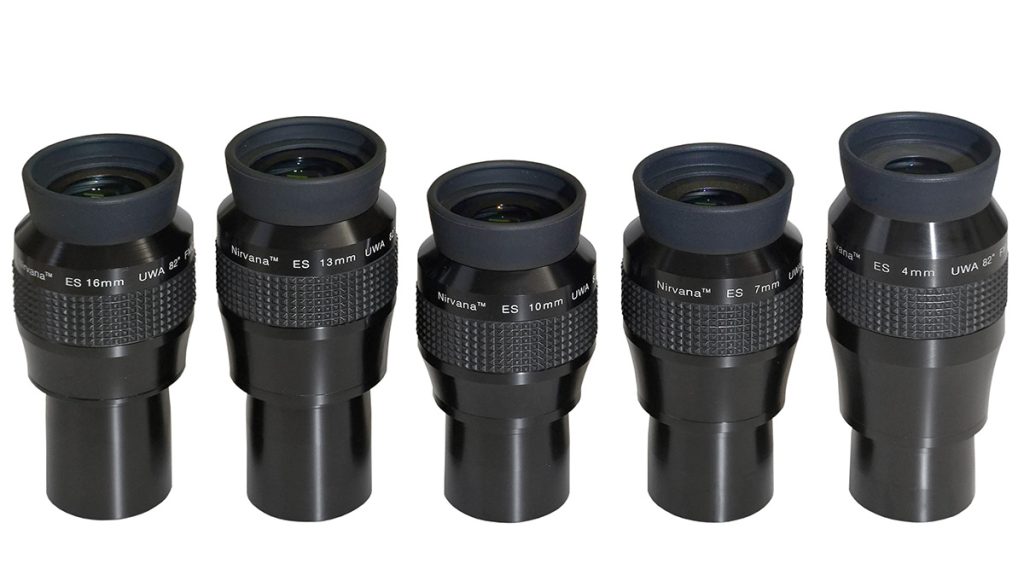
£65 – £125, Choice 2: StellaLyra UFF
- Available 2” focal lengths: 30mm
- Available 1.25” focal lengths: 24mm, 18mm, 15mm, 10mm
£65 – £125, Choice 3: Celestron Ultima Edge
Pros
- Wide 60-70 degree apparent field of view with no field curvature
- 24mm provides near maximum true field achievable in a 1.25” format
- Sharp in fast f/ratio telescopes
Cons
- 15mm and 10mm have narrower AFOV, poor eye relief and some lateral chromatic aberration, and are just clones of other cheaper eyepieces
- A little more expensive than other wide-angle offerings
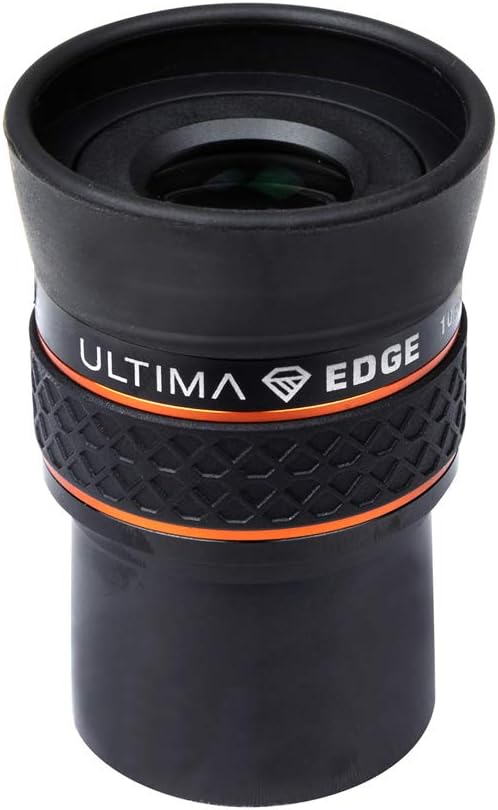
£65 – £125, Choice 4: APM UFF
- Available 2” focal lengths: 30mm
- Available 1.25” focal lengths: 24mm, 18mm, 15mm, 10mm
£65 – £125, Choice 5: StellaLyra Kitakaru
£65 – £125, Choice 6: Meade Series 5000 UHD
Pros
- Wide 60-70 degree apparent field of view with no field curvature
- 24mm provides near maximum true field achievable in a 1.25” format
- Sharp in fast f/ratio telescopes
Cons
- 15mm and 10mm have narrower AFOV, poor eye relief and some lateral chromatic aberration, and are just clones of other cheaper eyepieces
- A little more expensive than other wide-angle offerings
- Bulkier than other identical offerings from other brands
£65 – £125, Choice 7: OVL PanaView
Available 2” focal lengths: 38mm, 32mm, 26mm
Available 1.25” focal lengths: 20mm, 15mm, 10mm
Pros
- Affordable
- 70-degree apparent field of view
- Comfortable twist-up eyecups
Cons
- Sharpness falls off towards field of view edges, especially with 2” units and faster scopes
- 10mm short on eye relief
- 15mm and 20mm are essentially just goldline/redline clones
£65 – £125, Choice 8: RVO SWA
Available 2” focal lengths: 32mm, 26mm
Pros
- Affordable
- 70-degree apparent field of view
Cons
- Sharpness falls off towards field of view edges
- Not always the best value for your money
£65 – £125, Choice 9: Explore Scientific 62° Series Eyepieces
Pros
- Wide 62-degree apparent field
- Long eye relief at all focal lengths
- Fairly lightweight/compact
- Argon purging prevents fog or fungus
Cons
- Longer focal lengths not as immersive or sharp as ES68 equivalents
- Regular roll-up eyecups are not as ideal for this eyepiece design
- Some slight glare/scatter
£65 – £125, Choice 10: Tele-Vue Plossl
Tele-Vue’s Plossl eyepieces were their original product and have not changed much since their inception. All but the 55mm have a barrel diameter of 1.25 inches, and all but the 40mm have a field of view of 50 degrees. They are made to tighter tolerances than most cheaper Plossl eyepieces, though some other manufacturers over the years have rivaled or bested the Tele-Vue Plossl eyepieces’ performance.
55mm, 40mm, 32mm, 25mm, 20mm, 15mm, 11mm, and 8mm Plossl units are offered by Tele-Vue. The 55mm is great for night vision setups or use in Schmidt-Cassegrain telescopes; it simply provides too low of a magnification for faster Dobsonian telescopes and many refractors. The 40mm and 32mm offer the same true field of view; the 40mm’s larger exit pupil may come in handy but is usually not worth the compromise of a cramped 43-degree apparent field. The 15mm and shorter units have short eye relief, with the 8mm being quite uncomfortable to look through to the point that we don’t really recommend purchasing.
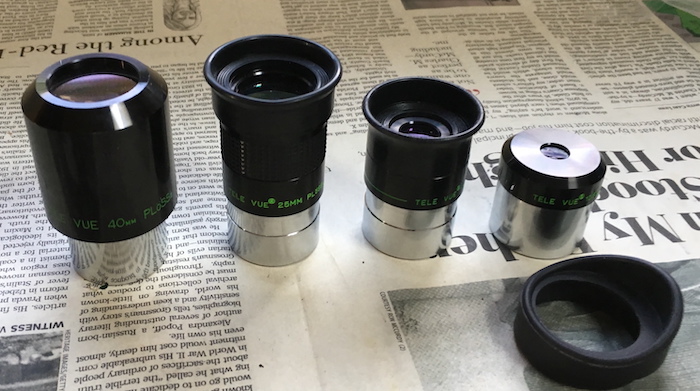
The Tele-Vue Plossl eyepieces are great, and they beat most of the other Plossl eyepieces out there, albeit at a much higher price. Unfortunately, considering that some of the Nagler knockoffs, or at least longer eye relief and equally sharp eyepieces like the “redline” or Agena Starguider, are available at the same price, it’s hard to really justify purchasing a Tele-Vue Plossl eyepiece unless you are the most demanding of observers and cannot afford any of Tele-Vue’s more expensive wide-field offerings.
£65 – £125, Choice 11: Vixen SLV
Pros
- Extremely sharp 50-degree apparent field
- Long eye relief at all focal lengths, unlike a regular Plossl
- Features simple twist-up eyecup
- Lanthanum glass for maximum sharpness
Cons
- 50-degree apparent field can be claustrophobic
- Really expensive for what you get
- You could just get a wide-angle eyepiece, and the central 50 degrees will be at least as sharp
£65 – £125, Choice 12: Explore Scientific 52-Degree
Pros
- Sharp 52-degree apparent field
- Long eye relief at all focal lengths, unlike a regular Plossl
- Fairly lightweight/compact
- Argon purging prevents fog or fungus
Cons
- 52-degree apparent field is kind of narrow
- Cheaper equivalents available, or you could get a wide-angle eyepiece for the same price
- Slight chromatic aberration
£65-£125, Choice 13: William Optics SWAN
- Available 2” focal lengths: 40mm, 33mm, 25mm
- Available 1.25” focal lengths: 20mm, 15mm, 9mm
£65-£125, Choice 15: Baader Classic Orthoscopic/Plossl
Available 1.25” focal lengths: 25mm, 18mm, 12.5mm, 9mm, 7mm, 6mm, 5mm, 4mm
£65-£125, Choice 16: Celestron X-Cel LX
Available 1.25” focal lengths: 25mm, 18mm, 12mm, 9mm, 7mm, 5mm, 2.3mm
£65 – £125, Choice 17: Celestron 8-24mm Zoom
£125 – £225 Price Range, Choice 1: APM/William Optics XWA
The APM/William Optics XWA eyepieces feature an astonishing 100-degree apparent field of view (110 degrees with the 5mm and 3.5mm models) and a sharp, well-corrected field at almost any focal ratio. The 20mm is ideal for low-power sweeping in any telescope with a 2” focuser, while the shorter focal lengths are great in almost any instrument thanks to their super-wide and super-sharp views. The extremely wide field is particularly beneficial when viewing at high powers with a manual telescope, as objects stay in view longer, while also being extremely immersive when viewing the Moon and star clusters.
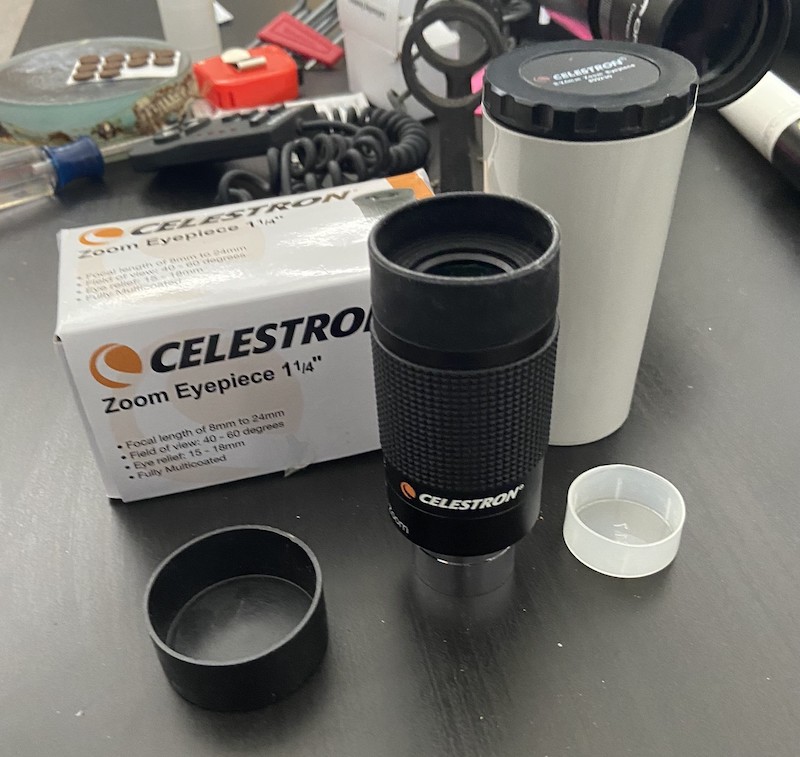
Available 2” focal lengths: 20mm
Available 1.25” focal lengths: 13mm, 9mm, 7mm, 5mm, 3.5mm
£125 – £225, Choice 2: Explore Scientific 82-Degree
The Explore Scientific 82-degree series are essentially copies of the old Meade Series 5000 UWA eyepieces, which themselves are extremely good emulations of the Tele-Vue Nagler design. They are available in 30mm, 24mm, 18m, 14mm, 11mm, 8.8mm, 8.5mm, 6.7mm, 6.5mm, 4.7mm, and 4.5mm focal lengths.
The 30mm, 24mm, and 18mm ES82s are 2” while remaining focal lengths are 1.25”. The ES82 design is similar to the Type 4 and Type 5 Nagler eyepieces, and they perform very well even in fairly fast f/ratio telescopes. However, the 14mm unit is known to have some slight edge-of-field aberrations and field curvature, while the 11mm, 8.8mm, 6.7mm, and 4.7mm units are rather short on eye relief. To solve the latter issue, Explore Scientific has introduced longer eye relief 8.5mm, 6.5mm, and 4.5mm units to replace the aforementioned shorter focal length eyepieces, with improved performance while reducing glare and other aberrations. They are similar to the Type 6 Nagler design. The 11mm, however, is still short on eye relief, while the 14mm is still a little subpar.
The 30mm, 24mm, and 18mm 2” ES82 eyepieces are all ideal low-power eyepieces for almost any telescope, and the 18mm is extremely lightweight at only 13.7oz, quite low for a 2” ocular, and ideal if you are concerned about the balance issues a heavier eyepiece might cause with your telescope. We don’t really recommend the 14mm and 1mm, or the older short focal length units, but the new LER 8.5mm, 6.5mm, and 4.5mm ES82s are extremely comfortable and sharp with great performance in almost any telescope.
Pros
- Wide 82-degree apparent field of view
- Cheaper than many other 82-degree eyepieces and sharper than bargain-basement models
- Argon purging prevents fog or fungus
Cons
- Eye relief at some focal lengths is extremely short
- Some performance issues with certain focal lengths
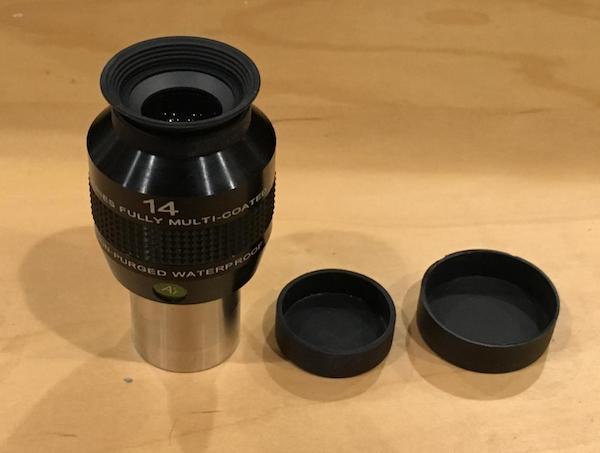
£125 – £225, Choice 3: Meade PWA
The Meade PWA eyepiece line is a budget option for those looking for well-corrected 82-degree AFOV eyepieces. They work surprisingly well in telescopes as fast as f/4. Compared to more expensive 82-degree eyepieces such as those from Explore Scientific and Tele-Vue, there are fewer focal length options, eye relief is shorter, and there is pronounced field curvature in the 16mm model. However, for the price, performance is superb. The 7mm PWA is also identical to the Celestron 7mm Luminos optically.
Pros
- Wide 82-degree apparent field of view
- Cheaper than most other 82-degree eyepieces
- Reasonably sharp in fast telescopes
Cons
- Eye relief is not great
- Some field curvature particularly in 16mm unit
- Some lateral chromatic aberration
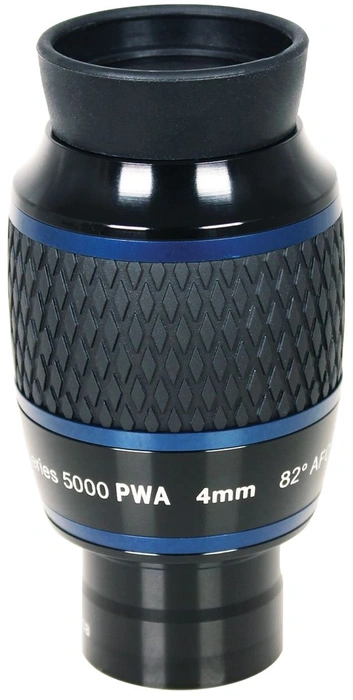
£125-£225, Choice 4: Antares Speers-Waler Series 3
£125 – £225, Choice 5: StellaLyra 80-Degree LER/Founder Optics MARVEL
The StellaLyra 80-degree LER (also sold as the Founder Optics MARVEL, and both being mere rebrands of the Long Perng 80-degree LER line) is a wide-angle eyepiece lineup similar to the various 82-degree UWA eyepieces but with more eye relief.
Available 2” focal lengths: 20mm, 14mm
Available 1.25” focal lengths: 9mm, 6mm, 4mm
£125 – £225, Choice 6: StellaLyra 68-Degree LER/Founder Optics ALIEN
The StellaLyra 68-degree LER/Founder Optics ALIEN is a complementary line to the Long Perng 80-degree LER oculars, featuring a long eye relief design with a 68-degree apparent field of view that remains sharp and well-corrected in almost any f/ratio telescope.
Available 1.25” focal lengths: 14.5mm, 12.5mm, 9mm, 6mm, 5mm, 3mm
£125 – £225, Choice 7: Explore Scientific 68° Series Eyepieces
Copycats of the Tele-Vue Panoptic eyepieces, which themselves are essentially corrected Erfle/SWA designs, the Explore Scientific 68-degree series eyepieces are available in 2” 40mm, 34mm, and 28mm focal lengths, along with 1.25” 24mm and 16mm units. The performance is essentially the same as a Panoptic; field curvature is a nuisance in faster telescopes, but for slower instruments, these are ideal and cost-effective low-power eyepieces. For telescopes limited to a 1.25” focuser, the 24mm ES68 is one of the best low-power eyepieces there is to max out your true field of view.
Pros
- Wide 68-degree apparent field, remains fairly sharp in fast f/ratio telescopes
- Maximum true field achievable in respective formats with 40mm and 24mm focal lengths
- Argon purging prevents fog or fungus
Cons
- Pincushion distortion/field curvature can be annoying
- Focal lengths too long for fast f/ratio telescopes
- Heavy
£125 – £225, Choice 8: Baader Hyperion
Baader’s Hyperion line was introduced in the mid-2000s to provide quality, relatively inexpensive wide-field eyepieces that fit both 1.25” and 2” focusers without the use of adapters.
The standard Baader Hyperions are available in seven focal lengths:
24mm which uses a slightly different optical design than the other six, 21mm, 17mm, 13mm, 10mm, 8mm and 5mm
A 3.5mm was made but it was discontinued due to lack of demand at that focal length for such an eyepiece – it is really only useful with small refractors at moderate f/ratios.
Baader also offers a Hyperion Zoom which is similar in name only and two “Hyperion Aspheric” eyepieces with 72-degree fields at 31mm and 36mm focal lengths. The Hyperion Aspherics are native 2” format and really designed to be used as 2” eyepieces only, as they will vignette with the included 1.25” adapters
£125 – £225, Choice 9: Celestron Luminos
Celestron’s Luminos eyepieces are an ultra-wide-angle eyepiece line that has been around for a while. While facing fierce competition from other UWA eyepieces, the Luminos is a decent pick for an ultra-wide-angle design. The Luminos eyepieces are available in 6 focal lengths: 2” barrel 31mm, 23mm, and 19mm focal lengths, along with 1.25” 15mm, 10mm, and 7mm units.
Celestron also sells a 2.5x, 2” Luminos-branded Barlow lens. This is a good Barlow lens, but we probably wouldn’t recommend it due to the weight and the overall lack of a good reason for purchasing a 2” Barlow.
£125-£225, Choice 10: Antares Speers-Waler Series 2
£125-£225, Choice 11: Takahashi Abbe
£125-£225, Choice 12: Baader Hyperion Aspheric
£225 – £350 Price Range, Choice 1: Tele-Vue Nagler Type 6
The Tele-Vue Naglers are 82-degree AFOV eyepieces. In that respect, they are similar to the Explore Scientific 82-degree line mentioned earlier. However, for your extra money, you get the finest manufacture, the best polish and coatings available, and more consistent quality and eye relief across all of the available focal lengths. Nagler eyepieces can be used with excellent results with any telescope, and the 1.25” Type 6 units are fairly compact too.
Pros
- Wide, sharp 82-degree apparent field of view
- Premium Tele-Vue quality
- 1.25” Type 6 Naglers are compact and lightweight
Cons
- 31mm Nagler is extremely heavy/bulky
- Type 6 1.25” Naglers have rather short eye relief
- Expensive
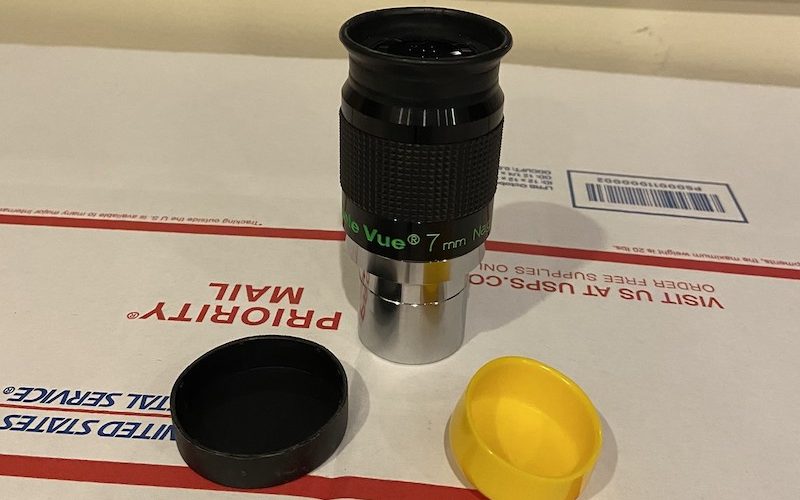
£225 – £350, Choice 2: Pentax SMC XW
The renowned Pentax XW eyepieces are highly valued by dedicated observers for their crisp, high-contrast images, longer eye relief, and wide apparent field of view. The XW23 and XW16.5 eyepieces boast an 85-degree apparent field of view, while other focal lengths in the PENTAX XW series offer a 70-degree apparent field of view. The entire series provides an extended 20mm eye relief, delivering an exhilarating wide-perspective image, and the twist-up eyecup makes it easy to put your eye at exactly the right distance and makes for a firm grip when holding these eyepieces too.
Pros
- Wide 85/70-degree apparent field of view
- Extremely sharp at any f/ratio
- Long eye relief
Cons
- Expensive
- Bulky
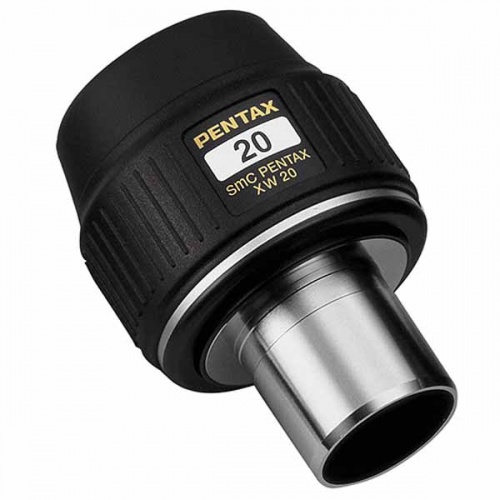
£225 – £350, Choice 3: Tele-Vue DeLite
For telescopes with tracking and a fast focal ratio that necessitate well-corrected and ultra-short focal length eyepieces, the Tele-Vue DeLite eyepieces are likely the most optimal choice for observing planets and double stars within their price bracket, slightly outperforming the Pentax and Baader offerings and with equally comfortable eye relief too. However, if you are more of a deep-sky observer and/or your telescope lacks motorized tracking, you may prefer an eyepiece with a wider apparent field in this price range, particularly when using a slower scope where edge-of-field correction is less crucial.
Pros
- Sharp 62-degree apparent field of view
- Good performance in fast scopes
- Long eye relief
- Premium build and optical quality
Cons
- Twist-up eyecup takes some getting used to
- 62-degree apparent field isn’t exactly the most immersive
- Expensive for what you get
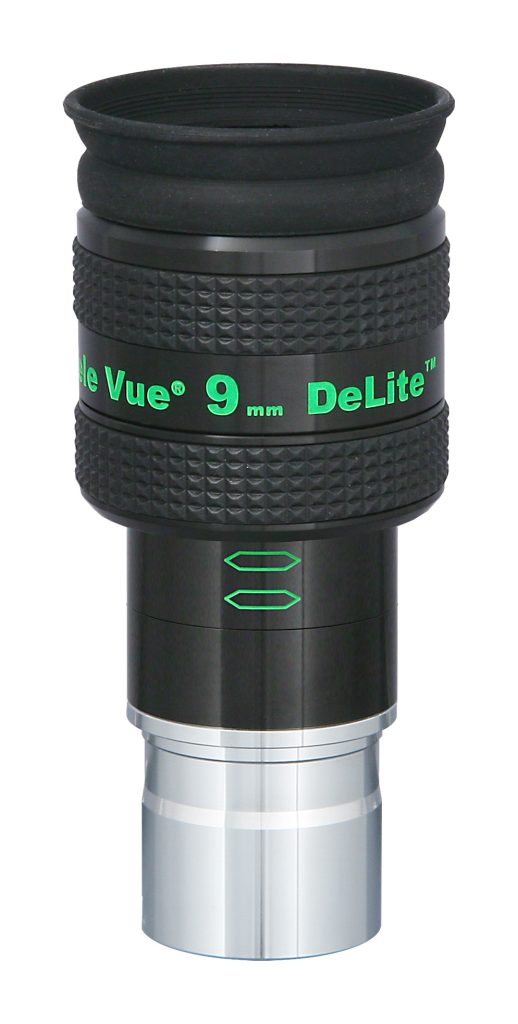
£225 – £350, Choice 4: Tele-Vue Panoptic
Panoptic eyepieces, like the Explore Scientific 68-degree eyepieces that copy them, are slightly sharper variants of the Erfle or “SWA” design used in many inexpensive wide-angle eyepieces. With a 68-degree apparent field of view, they work best with telescopes featuring focal ratios of f/4.5 or slower. The 24mm and 19mm models are suitable for binoviewers or small telescopes with 1.25″ eyepieces, while the 2” 41mm and 35mm Panoptics are better suited for large Schmidt-Cassegrain telescopes, where their larger exit pupils and lower magnification accommodate big f/10 SCTs. The 2” 27mm is a bit pointless.
Pros
- Wide 68-degree apparent field, remains fairly sharp in fast f/ratio telescopes
- Maximum true field achievable in respective 2”/1.25” size formats with 41mm and 24mm focal lengths
- Extremely high standard of quality typical of Tele-Vue products
Cons
- Pincushion distortion/field curvature can be annoying
- 2” focal lengths too long for fast f/ratio telescopes
- Heavy
| Eyepiece | Rating | Available Focal Length |
|---|---|---|
| Nikon NAV-SW | 4.2 | 1.25”- 17.5mm, 14mm, 10mm, 7mm, 5mm |
| Baader Hyperion 8-24mm Zoom | 4.2 | 1.25” – 32mm, 25mm |
| Masuyama 85-Degree | 4 | 1.25″ -16mm, 10mm 2″-32mm, 26mm, 20mm |
| Vernonscope Brandon | 4.1 | 1.25″ – 32mm, 25mm 2″ – 48mm |
£350+ Price Range, Choice 1: Nikon NAV-HW
Nikon’s internationally successful NAV-SW series has paved the way for the new NAV-HW series, boasting an ultra-wide 102-degree field of view. This series features two focal lengths: the 1.25″/2″ 12.5mm NAV-12.5HW and the 2″ 17mm NAV-17HW. Each eyepiece comes with a specially designed “EiC” tele-extender lens at no extra cost, which can be screwed onto the bottom of each eyepiece, reducing the focal length of the 17mm HW to 14mm and the 12.5mm to 10mm. This means you effectively receive two eyepieces for the price of one!
The 17mm NAV-HW’s barrel is unnecessarily long, and for use with a coma corrector like the Tele-Vue Paracorr or ES HRCC, you may end up having to install a parfocalizing ring to keep the bottom of the eyepiece as close as possible to the coma corrector lens without actually touching it. Nikon provides one, but it is actually too thick for this purpose, though it is necessary to avoid hitting the mirror/prism in a 2” star diagonal.
Compared to the Tele-Vue Ethos eyepieces (below) the NAV-HW eyepieces are just a little comfier, a little crisper, and offer a slightly wider field. Since prices are similar, by all means go with the Nikons if you are choosing between the 17mm/13mm/10mm Ethos and the NAV-HWs. These eyepieces are extremely immersive and sharp even in the fastest f/ratio scopes.
Pros
- Sharp, wide, extremely immersive 102-degree apparent field of view
- Excellent performance at all focal ratios
- Long eye relief
- Premium build and optical quality
- Glow in the dark eyeguard
- 2-for-1 package thanks to provided Barlow/tele-extender lens
Cons
- Winged eyecup takes some getting used to
- 17mm has issues with spacing/back focus if you use a coma corrector or star diagonal
- Expensive
- Weird caps
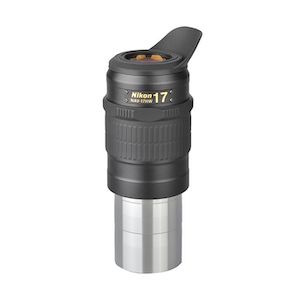
£350+, Choice 2: Tele-Vue Ethos
The Tele-Vue Ethos design employs over eight lens components to attain an incredibly sharp, well-corrected apparent field of view spanning 100 degrees. The 3.7mm and 4.7mm Ethos-SX eyepieces offer an even broader 110-degree apparent field of view. Compatible with telescopes as fast as f/2.6, the Ethos design exhibits minimal aberrations, with only some moderate field curvature in the longer focal lengths. All models provide a satisfactory amount of eye relief. The shorter Ethos eyepieces’ 100-degree and 110-degree apparent fields prove particularly useful in non-tracking telescopes like Dobsonians, extending the duration objects remain in view and enhancing the immersive experience when observing the Moon and large, luminous deep-sky objects like the Orion Nebula.
Pros
- Sharp, wide, extremely immersive 100/110-degree apparent field of view
- Excellent performance at all focal ratios
- Premium build and optical quality
Cons
- Not the best with eye relief
- 2”/1.25” hybrid barrels with 6/8/10/13mm can be confusing with reaching focus properly, especially if used in conjunction with regular 2” eyepieces and/or coma corrector
- Expensive
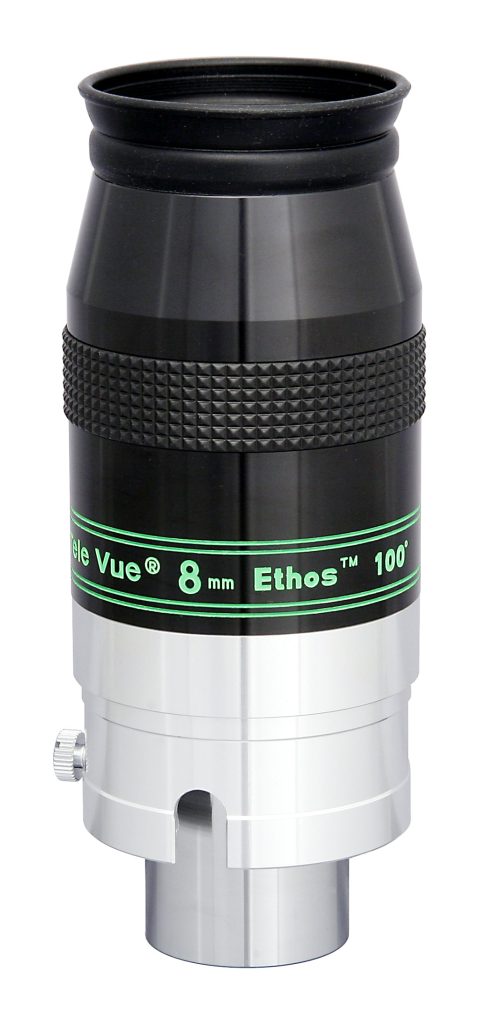
£350+, Choice 3: Explore Scientific 92° Series Eyepieces
Explore Scientific’s 92-degree eyepieces are optimized for long eye relief, and are available only in two focal lengths – 17mm and 12mm in 2” barrels. These eyepieces are similar to the ES100 optical design but trade some of the apparent field of view for greater eye relief, which makes for a much more comfortable viewing experience. The eye lenses are also enlarged. The ES92 eyepieces are a little sharper and provide better contrast than the ES100 eyepieces, though the former is partly due to the restricted apparent field of view, which of course shows fewer edge-of-field aberrations in fast f/ratio telescopes.
The ES92 eyepieces are both quite heavy, at 47 oz for the 17mm and 38.4 oz for the 12mm. This is, as with the ES100s, important to keep in mind if you plan on using them with smaller telescopes.
Pros
- Huge 92-degree apparent field which is sharp at any focal ratio
- Plenty of eye relief, with large eye cups
- Argon purging prevents fog or fungus
Cons
- Heavy
- Not as immersive as 100-degree apparent field
- Only two focal lengths available
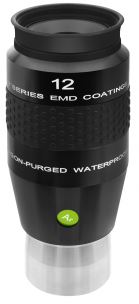
£65 – £125, Choice 4: Tele-Vue Delos
The Delos eyepieces are essentially the same optical design as Ethos eyepieces, with narrower lenses and a narrower true field of view. This results in a cheaper eyepiece with extremely long eye relief. With an apparent field of view of 72 degrees, the Delos design gives almost perfect views with almost no aberrations at any focal ratio and in any type of telescope. If you are forced to wear eyeglasses at the eyepiece due to astigmatism (though Tele-Vue sells Dioptrix correctors for that), the Delos line is probably ideal for you.
The Delos lineup consists of solely 1.25” eyepieces in 17.3mm, 14mm, 12mm, 10mm, 8mm, 6mm, 4.5mm, and 3.5mm focal lengths. Like the Type 4 Naglers, the Delos uses a click-up eye guard; the rubber eyecup is attached to a cylindrical housing that can be slid up and down the eyepiece, then locked in place for the most comfortable possible position.
Some deep-sky observers swear by the Delos line, claiming it provides slightly brighter and crisper views than an Ethos or Nagler. This is actually complete nonsense, as the Ethos uses the same amount and design of lenses with identical coatings as the Delos; it is physically impossible for them to be different in performance. For the most part, the Delos is kind of a niche product, and its main market is really just people who choose to wear glasses at the eyepiece; you can get a Nagler or an Ethos knockoff for the same price, and either is going to be just as sharp but provide a wider field of view.
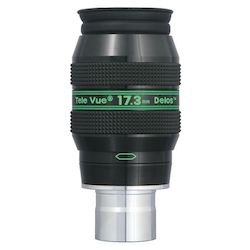
The Baader Morpheus eyepiece line is optically and performance-wise very similar to the Delos design, with a slightly wider 76-degree apparent field of view. The Pentax XW largely duplicates the Delos in function as well, with a 70-degree apparent field and massive eye relief. All three designs are great, though again, a Nagler or Ethos is probably what you want.
£350+, Choice 5: Explore Scientific 100° Series Eyepieces
Explore Scientific’s 100-degree eyepieces are copies of the Tele-Vue Ethos design to some extent, and feature the same 100-degree apparent field of view – except for the 25mm, which has an apparent field of only 95 degrees due to limitations of the optical design. They are available in 30mm, 25mm, 20mm, 14mm, 9mm, and 5.5mm focal lengths. The biggest difference in optical configuration between the ES100 and Ethos is the ES100s’ use of a concave eye lens. This means that they have shorter practical eye relief than technically specified, by around 4mm, and are thus not as comfortable for astronomy outreach purposes or eyeglasses wearers. Additionally, the concave eye lens is more prone to reflecting glare from light pollution, the Moon, and other sources back into your eye.
Prior to 2022, the ES100 line was considered a bargain alternative to the Tele-Vue Ethos line. These days, it is not universally the case. The 20mm ES100 is around the same price as the 21mm and 17mm Tele-Vue Ethos oculars, which are sharper and don’t feature the nuisance of concave eye lenses. The APM/Lunt/Astro-Tech XWA line is arguably equal to or superior to the ES100s and features 1.25” barrels for the shorter focal lengths, along with no concave eye lenses, lighter weight, and lower pricing.
With the exception of the 30mm 3” unit, the Explore Scientific 100-degree oculars are all 2”-only despite the fact that the 5.5mm, 9mm, and 14mm would actually work fine in a 1.25” barrel. You can use them with impunity in telescopes like a 6” SCT or a 5” Maksutov that will not actually illuminate a field stop wider than 1.25”, but attempting to adapt them to a Newtonian or refractor with a 1.25” focuser is probably a bad idea due to their weight and potential issues reaching focus.
The 30mm ES100 is a great eyepiece, but you might struggle to find a telescope that has a 3” focuser to accommodate it where such an eyepiece is worthwhile. However, in a long focal length Cassegrain, for instance, it is spectacular and sharp right out to the edges.
The 25mm ES100 has a wider field stop than any other eyepiece with a 90+ degree apparent field, and due to its pushing of the limits of optical design, it does have some edge-of-field astigmatism in fast f/ratio telescopes. However, it is still very comfortable to use and very sharp, while offering a capability no other 90-100 degree eyepiece line can attain.
The other ES100 eyepieces are decently well-corrected, but the 20mm and 14mm suffer from noticeable edge-of-field astigmatism in telescopes faster than f/3.5. The concavity of the eye lens is also, of course, somewhat annoying if you have any sources of glare/etc unless you put your face directly up against the eyeguard. However, they are still great eyepieces and work very well in almost any telescope.
In addition to the ES100 line, Explore Scientific sells a single 120-degree apparent field eyepiece in a 9mm focal length. This eyepiece is over 1,000 Pounds new when not on sale, but is well worth the price. Due to some interesting optical distortions with such a wide field of view, the field stop, or true field, is equivalent to that of a 140-degree apparent field eyepiece at this focal length (around 22mm), but the outer edges of the 9mm ES120’s field are “compressed” in such a way to deliver only a 120-degree apparent field. Eye relief is pretty short; the provided eyecup is often just a smidge too tall, while using the eyepiece with the eyecup rolled down gives the concave eye lens more opportunity to reflect sources of glare. Additionally, lateral chromatic aberration impacts planets and bright stars as they pass around the central 70-80 degrees of the field. However, for viewing the Moon and deep-sky objects – where the 120-degree apparent field is most useful anyways – this eyepiece is spectacular.
The ES100/120 eyepieces are heavy – the 5.5mm is the lightest at 21.6 oz/612 g, while the 25mm weighs 41.5 oz. The monster 30mm 3” weighs in at 83 oz. This can affect balance with telescopes that do not have adjustable or very large bearings of some sort.
Pros
- Huge 95/100/120-degree apparent field (depending on focal length)
- Some focal lengths sharp even in super-fast f/3 instruments
- Argon/nitrogen purging prevents fog or fungus
Cons
- Heavy
- Most focal lengths not cost-effective compared to other options
- Glare and eye relief issues due to concave eye lens

